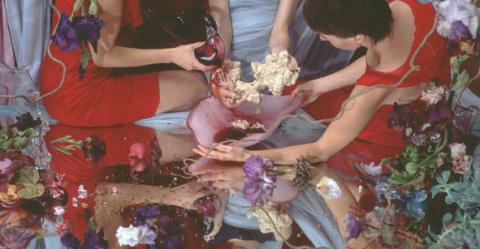Margriet Smulders
Bread and Wine (2003, photography)
Tias Building

In the hall of TIAS Building, there is large work of art from 2003 by the Nijmegen artist Margriet Smulders. It bears the title 'Sharing bread and wine' and symbolizes the good cooperation between architect, contractor ,and client in the new building. The work is literally based on a large mirror, in combination with glass goblets (blown by Bernard Heesen) from which wine flows abundantly. The splendor of color and form of the work is a good counterbalance to the austere, sober building by architect Walter van Oerle.
Margriet Smulders (Bussum, 1955) studied at the art academy in Enschede, but also completed a program in psychology at the University of Nijmegen. Since the turn of the century, she makes staged flower still lifes. She builds on large mirrors with specially blown glass bowls and vases; agile still lifes that she douses with water, inks, milk, and—in this work—red wine. Her flower still lifes are inspired by seventeenth-century Dutch flower still lifes, yet deviate greatly from them because of the staging, use of color and reflections. Margriet Smulders wants the viewer to lose him/herself, to become “drunk” while looking at her work.
In a metaphorical sense, the work refers to the breaking and sharing of (unleavened) bread and wine as done during the Last Supper by Jesus for his disciples on the evening before his crucifixion. In Catholic tradition, it is believed that this is how Jesus instituted the Eucharist, in which the words Jesus used when breaking the bread and sharing the wine ("Take and eat; this is my body"; "this is my blood which is poured out for you") are repeated by priests in the Eucharistic prayer.
Moreover, the idea of community, which is central to the artwork, is appropriate given that the term “university” is derived from the Latin universitas magistrorum et scholarium. Freely translated: the community of teachers and scholars.
Margriet Smulders' work is included in a large number of collections and museums, including the Bibliothèque National in Paris, the Bonnefanten Museum in Maastricht, the Noord Brabants Museum in 's-Hertogenbosch, the Ministry of Foreign Affairs, Radboud University, and Valkhof Museum in Nijmegen.
More about history and academic heritage
The Tilburg University academic heritage is a very diverse set of archives, visual materials, collections, devices, recorded stories, et cetera that relate to the history of the university.